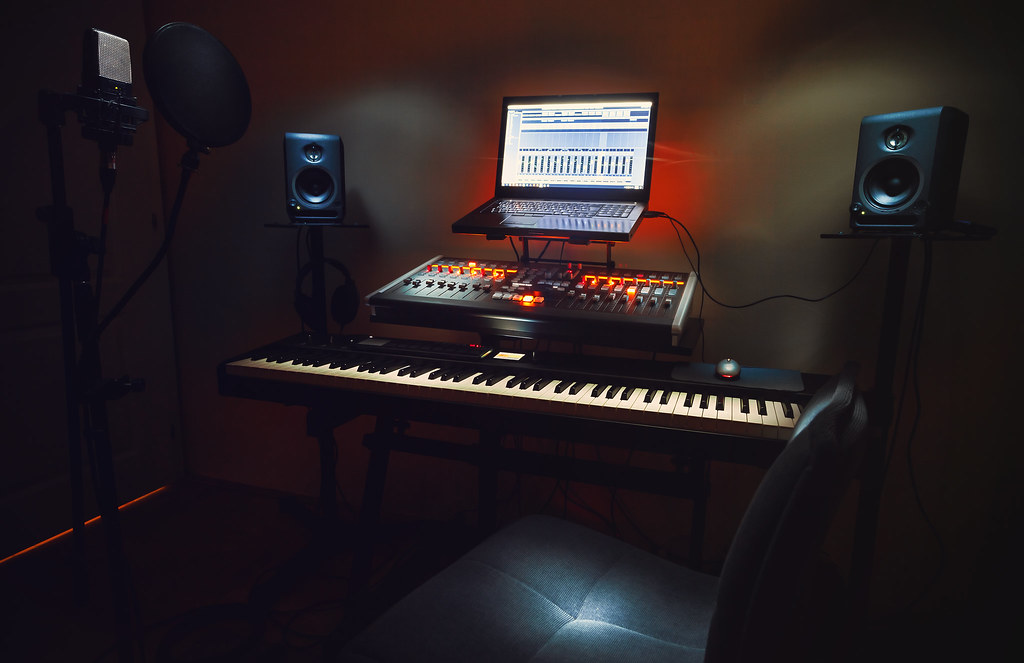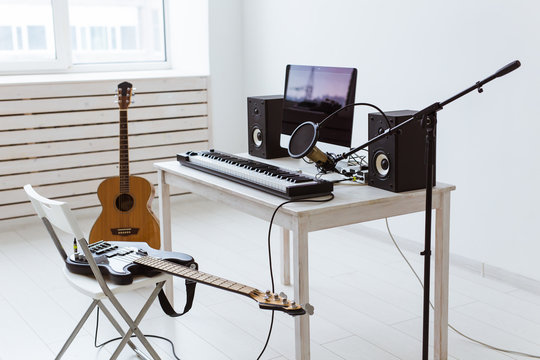Are you looking for the perfect studio desk for music production but don’t know where to start? Look no further! A studio desk designed specifically for music production can greatly enhance your productivity and workflow. In this article, we will guide you through the process of choosing the ideal studio desk for your home recording setup. We will cover essential factors to consider when choosing a desk, such as size, ergonomics, durability, and cable management. We’ll also explore the different types of studio desks available, including straight, L-shaped, adjustable height, and corner desks. Plus, we’ll provide reviews and comparisons of some of the top studio desks for music production. Whether you’re a professional music producer or just starting, this article will help you find the perfect studio desk to take your music production to the next level.
Table of Contents

Choosing the Perfect Studio Desk for Music Production
When choosing a studio desk for music production, there are several important factors to consider. By keeping these in mind, you can ensure that you choose a desk that suits your needs and provides a comfortable and efficient workspace.
Factors to Consider When Choosing a Studio Desk
-
Size and Layout: Consider the size and layout of your workspace when choosing a studio desk. You’ll want to choose a desk that fits well in your space and provides enough room for your equipment and instruments, as well as enough room for you to work comfortably.
-
Ergonomics and Comfort: Ergonomics are essential to your comfort and productivity when working at a studio desk. Look for desks that offer adjustable height options, a comfortable keyboard tray, and monitor placement that reduces eye and neck strain.
-
Durability and Quality: A desk that is built to last is essential when holding expensive equipment and instruments. Look for desks made from sturdy materials such as solid wood or metal and those that offer high-quality construction.
-
Cable Management: Proper cable management is key to keeping your workspace organized and preventing cable tangles and tripping hazards. Look for desks with built-in cable management systems or plan to incorporate cable ties and clips.
Types of Studio Desks
After considering the above factors, it’s time to explore the various types of studio desks available. Here are some common types:
-
Straight Desks: Straight desks are the most basic type of studio desk, providing a simple and straightforward workspace. They are ideal for smaller spaces or those on a budget.
-
L-Shaped Desks: L-shaped desks provide more surface area than straight desks, making them ideal for larger workspaces or those needing more room for equipment and instruments.
-
Adjustable Height Desks: Adjustable height desks allow you to customize the height of your work surface, providing a more ergonomic workspace for your body.
-
Corner Desks: Corner desks are designed to fit snugly into the corner of a room, making them ideal for maximizing space in smaller areas.
-
Studio Workstations: Studio workstations are large, complex desks that provide ample surface area for multiple pieces of equipment and instruments. They often include built-in racks for audio interfaces and rack-mountable gear, as well as other features such as cable management and sliding keyboard trays.

Top Studio Desks for Music Production
Choosing the best studio desk for music production can be challenging, and it’s important to consider several factors such as price, size, and features. Here are some of the top studio desks for music production that are worth considering:
Studio Desk Reviews
-
Studio RTA Producer Station Desk: This versatile desk offers ample space for your equipment and instruments, with a built-in rack for your audio interface and rack-mountable gear. It also includes a cable management system and a sliding keyboard tray for added comfort.
-
On-Stage WSC7500 Workstation Corner Desk: This L-shaped desk is perfect for maximizing workspace in a smaller room. It features a steel frame and melamine top, as well as a cable management system and built-in monitor stands.
-
Omnirax Presto 4 Studio Desk: This compact and stylish desk is ideal for smaller studios. It features a sliding keyboard tray, cable management system, and built-in monitor stands.
-
Argosy Halo.K88 Ultimate Workstation: This high-end studio desk is designed for professional producers who demand the best. It features an ergonomic design, ample workspace, built-in cable management, and a customizable modular design.
Comparison of Studio Desks
When comparing studio desks, it’s important to consider the following factors:
-
Price: Compare prices from different retailers and determine your budget before you start shopping. A high-quality desk can be a significant investment, so consider the long-term benefits.
-
Size and Layout: Consider the size of your workspace and the amount of equipment and instruments you need to accommodate. Choose a desk that offers ample space and a layout that works for your needs.
-
Features: Look for desks that offer built-in cable management, monitor stands, and other features that will help you stay organized and productive.
How to Choose the Perfect Studio Desk for Your Budget
Choosing the perfect studio desk for music production on a budget can be challenging. Here are some tips to help you make the right choice:
-
Set a budget: Determine your budget before you start shopping to avoid overspending and narrow down your options.
-
Consider used or refurbished desks: You can find high-quality studio desks for a fraction of the price by purchasing used or refurbished desks. Check online marketplaces or local music stores for deals.
-
Prioritize features: Determine which features are most important to you and prioritize them when choosing a desk. For example, if cable management is a priority, look for desks with built-in cable management systems.
By considering these tips, you can choose the perfect studio desk for your music production needs without breaking the bank.
Setting Up Your Studio Desk
Once you’ve chosen the perfect studio desk for your music production needs, it’s time to set it up properly for maximum productivity and comfort. Here are some best practices to follow:
Proper Placement
Set up your desk in a location that provides ample space and natural light. Consider the orientation of your desk and ensure that it’s facing away from any windows to avoid glare on your computer screen. This will help you stay focused and productive.
Cable Management
Use cable ties and clips to keep your cables organized and prevent tripping hazards. Consider adding a cable tray or shelf to keep your equipment off the floor and out of the way. This will help you keep your workspace clean and organized, reducing distractions and improving your workflow.
Ergonomics and Comfort
Adjust your monitor, keyboard, and chair to ensure that you’re in a comfortable and ergonomic position. Consider investing in a standing desk or adjustable height desk for added comfort. This will help reduce strain on your back, neck, and shoulders, allowing you to work for longer periods without discomfort.
Organize Your Workspace
Keep your desk organized by using drawers, shelves, and other storage solutions to store your equipment and instruments. This will help you stay focused and productive, reducing distractions and allowing you to find what you need quickly and easily.
Personalize Your Space
Add personal touches to your workspace, such as photos or artwork, to make it a comfortable and inspiring place to work. This will help boost your creativity and motivation, ultimately enhancing your music production capabilities.
Building Your Own DIY Studio Desk
Building your own DIY studio desk is a great option if you’re on a tight budget or want to customize your workspace to your specific needs. Here are the benefits of building your own studio desk:
Benefits of Building Your Own Studio Desk
-
Customization: Building your own studio desk allows you to customize it to fit your specific needs, ensuring that it fits your equipment and workspace perfectly. You can choose the size, layout, and materials that work best for you.
-
Cost Savings: Building your own studio desk can be much cheaper than buying a pre-made desk, especially if you already have some of the necessary materials. You can save money by using materials you already have or by purchasing materials in bulk.
-
Satisfaction of Building Your Own Desk: Building your own studio desk can be a fun and rewarding experience, providing a sense of satisfaction and accomplishment. You’ll have a desk that is unique to you and your needs, and you’ll be able to take pride in your work.
Steps for Building a DIY Studio Desk
If you’re considering building your own studio desk, here are some steps to follow:
-
Planning and Measuring: Determine the size and layout of your desk, taking into account your available workspace and equipment. Measure your workspace carefully to ensure that your desk fits well. Consider factors such as legroom, monitor height, and cable management.
-
Materials and Tools Needed: Gather all of the necessary materials and tools, including wood, screws, saws, sandpaper, and a drill. Consider using high-quality materials such as solid wood or metal for durability.
-
Assembly and Finishing: Assemble your desk according to your plans, ensuring that all parts fit together correctly and securely. Sand and finish your desk to ensure that it’s smooth and looks professional. Consider adding additional features such as cable management holes or a keyboard tray.
By following these steps, you can build a customized studio desk that meets your specific needs and enhances your music production capabilities. Building your own desk can be a fun and rewarding experience, and you’ll have a workspace that is unique to you and your needs.

Studio Desk Accessories
In addition to the essential accessories listed above, there are several other accessories that can enhance your studio desk setup:
Essential Accessories for Music Production
-
Studio Monitor Speakers: Studio monitor speakers provide high-quality sound reproduction, allowing you to accurately hear and mix your music. Look for speakers that offer a flat frequency response and a wide dynamic range to ensure that you hear your music as it was intended.
-
Audio Interfaces: Audio interfaces allow you to connect your instruments and equipment to your computer, providing high-quality recording and playback capabilities. Look for interfaces with low latency and high sample rates for the best performance.
-
MIDI Controllers: MIDI controllers allow you to control your software instruments and digital audio workstations with ease, providing a more intuitive and expressive way to create music. Look for controllers with a variety of knobs, faders, and pads to suit your specific needs.
-
Microphones: Quality microphones are essential for recording vocals and acoustic instruments, providing clear and accurate sound reproduction. Look for microphones that offer a flat frequency response and low self-noise for the best results.
Optional Accessories to Enhance Your Studio Desk Setup
-
Headphone Amplifiers: Headphone amplifiers provide high-quality sound reproduction and volume control for your headphones, allowing you to hear your music with clarity and precision. Look for amplifiers with low distortion and high output power for the best performance.
-
External Hard Drives: External hard drives provide additional storage space for your music files and projects, ensuring that you never run out of space. Look for drives with fast read and write speeds and ample storage capacity.
-
Desk Lamps: Desk lamps provide additional lighting for your workspace, helping to reduce eye strain and improve visibility. Look for lamps with adjustable brightness and color temperature to suit your specific needs.
Conclusion
In conclusion, a specialized studio desk is a crucial investment for any music producer looking to create a comfortable, efficient, and productive workspace. By considering the factors listed above, exploring the various types of studio desks available, and selecting essential accessories, you can create a workspace that meets your specific needs and enhances your music production capabilities. Whether you choose a pre-made desk or build your own DIY desk, investing in a specialized studio desk will not only improve your workflow but also enhance the quality of your music production.
At [Your Company Name], we offer a range of content to help you build the perfect home recording studio. From choosing the right equipment to setting up your workspace, we’re dedicated to helping you achieve your music production goals. Check out our other articles and resources to learn more about creating the perfect home recording studio today.
Questions and Answers
Who should use a studio desk for music production?
Anyone who produces music at home can benefit from a dedicated studio desk.
What makes a studio desk suitable for music production?
A good studio desk for music production should be ergonomic, durable, and have proper cable management.
How can I choose the right size studio desk for my space?
Measure your available space and choose a desk that fits well and provides enough room for your equipment and instruments.
What if I don’t have a lot of money to spend on a studio desk?
Consider building your own DIY studio desk or purchasing a used or refurbished desk to save money.
How can I set up my studio desk for maximum productivity?
Prioritize ergonomics and comfort, organize your workspace, and personalize your space to boost creativity and motivation.
What accessories should I consider for my studio desk setup?
Essential accessories include studio monitor speakers, audio interfaces, MIDI controllers, and microphones. Optional accessories include headphone amplifiers, external hard drives, and desk lamps.


